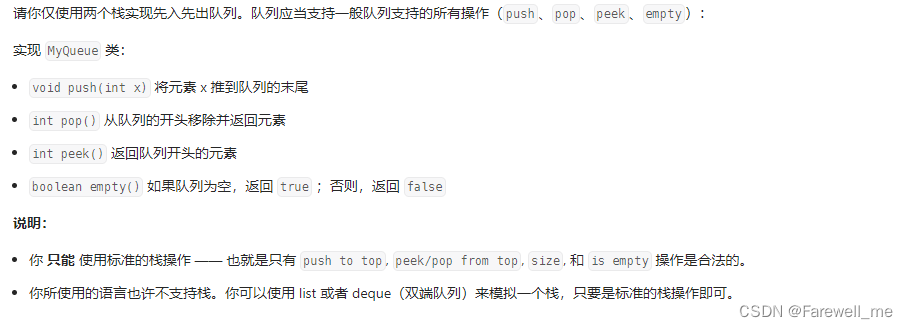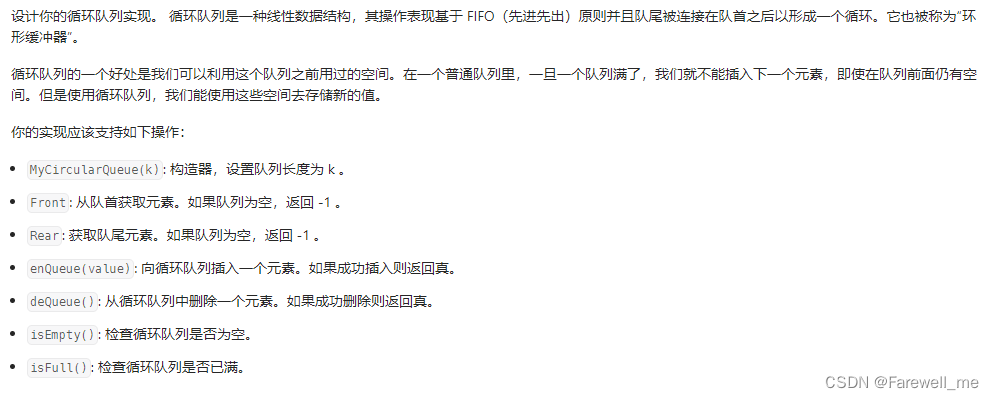文章目录
- 前言
- 一、有效的括号
- 二、用队列实现栈
- 三、 用栈实现队列
- 四、设计循环队列
- 总结
前言
leetcode栈和队列的相关题、有效的括号、用队列实现栈、用栈实现队列、设计循环队列等介绍
一、有效的括号
leetcode有效的括号

// 动态增长的栈
typedef char STDataType;
typedef struct Stack
{STDataType* a;int top;int capacity;
}ST;// 初始化栈
void STInit(ST* ps);// 销毁栈
void STDestroy(ST* ps);// 插入
void STPush(ST* ps, STDataType x);// 出栈
void STPop(ST* ps);// 检查是否为空
bool STEmpty(ST* ps);// 获取栈顶元素
STDataType STTop(ST* ps);//获取有效元素的个数
int STSize(ST* ps);// 初始化栈
void STInit(ST* ps)
{assert(ps);ps->a = (STDataType*)malloc(sizeof(STDataType) * 4);if (ps->a == NULL){perror("STInit malloc");return;}ps->top = 0; // top指的是栈顶元素的下一个位置//ps->top = -1; // top 指的是栈顶元素ps->capacity = 4;
}// 销毁栈
void STDestroy(ST* ps)
{assert(ps);free(ps->a);ps->a == NULL;ps->top = 0;ps->capacity = 0;
}// 入栈
void STPush(ST* ps, STDataType x)
{assert(ps);if (ps->top == ps->capacity){STDataType* tmp = (STDataType*)realloc(ps->a, sizeof(STDataType) * ps->capacity * 2);if (tmp == NULL){perror("STPush relloc");return;}ps->a = tmp;ps->capacity *= 2;}ps->a[ps->top] = x;ps->top++;
}// 出栈
void STPop(ST* ps)
{assert(ps);assert(!STEmpty(ps));ps->top--;
}// 检查是否为空
bool STEmpty(ST* ps)
{assert(ps);return ps->top == 0;
}// 获取栈顶元素
STDataType STTop(ST* ps)
{assert(ps);assert(!STEmpty(ps));return ps->a[ps->top - 1];
}// 获取有效元素的个数
int STSize(ST* ps)
{assert(ps);return ps->top;
}bool isValid(char* s) {ST st;STInit(&st);while(*s){if(*s == '(' || *s == '[' || *s == '{'){STPush(&st, *s);}else{if(STEmpty(&st)){STDestroy(&st);return false;}char top = STTop(&st);STPop(&st);if((*s == ')' && top != '(')|| (*s == ']' && top != '[')|| (*s == '}' && top != '{')){STDestroy(&st);return false;}}s++;}bool ret = STEmpty(&st);STDestroy(&st);return ret;
}
二、用队列实现栈
leetcode用队列实现栈

typedef int QDataType;typedef struct QueueNode
{struct QueueNode* next;QDataType data;
}QNode;typedef struct Queue
{QNode* head;QNode* tail;int size;
} Queue;// 初始化队列
void QInit(Queue* pq)
{assert(pq);pq->head = pq->tail = NULL;pq->size = 0;}// 销毁队列
void QDestroy(Queue* pq)
{assert(pq);QNode* cur = pq->head;while (cur){QNode* next = cur->next;free(cur);cur = next;}pq->head = pq->tail = NULL;pq->size = 0;
}// 入队列
void QPush(Queue* pq, QDataType x)
{assert(pq);QNode* newnode = (QNode*)malloc(sizeof(QNode));if (newnode == NULL){perror("QPush()::malloc()");return;}newnode->next = NULL;newnode->data = x;if (pq->head == NULL){assert(pq->tail == NULL);pq->head = pq->tail = newnode;}else{pq->tail->next = newnode;pq->tail = pq->tail->next;}pq->size++;
}// 出队列
void QPop(Queue* pq)
{assert(pq);assert(pq->head != NULL);if (pq->head->next == NULL){free(pq->head);pq->head = pq->tail = NULL;}else{QNode* cur = pq->head;pq->head = cur->next;free(cur);cur = NULL;}pq->size--;}// 获取队列元素个数
int QSize(Queue* pq)
{assert(pq);return pq->size;
}// 判断队列是否为空
bool QEmpty(Queue* pq)
{assert(pq);return (pq->head == NULL && pq->tail == NULL);
}// 找到队列的头元素
QDataType QFront(Queue* pq)
{assert(pq);assert(!QEmpty(pq));return (pq->head->data);
}// 找到队列的尾元素
QDataType QBack(Queue* pq)
{assert(pq);assert(!QEmpty(pq));return (pq->tail->data);
}typedef struct {Queue q1;Queue q2;
} MyStack;MyStack* myStackCreate() {MyStack* pst = (MyStack*)malloc(sizeof(MyStack));if(pst == NULL){perror("myStackCreate malloc");return NULL;}QInit(&pst->q1);QInit(&pst->q2);return pst;
}void myStackPush(MyStack* obj, int x) {if(!QEmpty(&obj->q1)){QPush(&obj->q1, x);}else{QPush(&obj->q2, x);}
}int myStackPop(MyStack* obj) {Queue* empty = &obj->q1;Queue* nonempty = &obj->q2;if(!QEmpty(&obj->q1)){empty = &obj->q2;nonempty = &obj->q1;}while(QSize(nonempty) > 1){QPush(empty, QFront(nonempty));QPop(nonempty);}int top = QFront(nonempty);QPop(nonempty);return top;
}int myStackTop(MyStack* obj) {if(!QEmpty(&obj->q1)){return QBack(&obj->q1);}else{return QBack(&obj->q2);}
}bool myStackEmpty(MyStack* obj) {return (QEmpty(&obj->q1) && QEmpty(&obj->q2));
}void myStackFree(MyStack* obj) {QDestroy(&obj->q1);QDestroy(&obj->q2);obj = NULL;
}/*** Your MyStack struct will be instantiated and called as such:* MyStack* obj = myStackCreate();* myStackPush(obj, x);* int param_2 = myStackPop(obj);* int param_3 = myStackTop(obj);* bool param_4 = myStackEmpty(obj);* myStackFree(obj);
*/
三、 用栈实现队列
leetcode用栈实现队列

// 动态增长的栈
typedef int STDataType;
typedef struct Stack
{STDataType* a;int top;int capacity;
}ST;// 初始化栈
void STInit(ST* ps);// 销毁栈
void STDestroy(ST* ps);// 插入
void STPush(ST* ps, STDataType x);// 出栈
void STPop(ST* ps);// 检查是否为空
bool STEmpty(ST* ps);// 获取栈顶元素
STDataType STTop(ST* ps);//获取有效元素的个数
int STSize(ST* ps);// 初始化栈
void STInit(ST* ps)
{assert(ps);ps->a = (STDataType*)malloc(sizeof(STDataType) * 4);if (ps->a == NULL){perror("STInit malloc");return;}ps->top = 0; // top指的是栈顶元素的下一个位置//ps->top = -1; // top 指的是栈顶元素ps->capacity = 4;
}// 销毁栈
void STDestroy(ST* ps)
{assert(ps);free(ps->a);ps->a == NULL;ps->top = 0;ps->capacity = 0;
}// 入栈
void STPush(ST* ps, STDataType x)
{assert(ps);if (ps->top == ps->capacity){STDataType* tmp = (STDataType*)realloc(ps->a, sizeof(STDataType) * ps->capacity * 2);if (tmp == NULL){perror("STPush relloc");return;}ps->a = tmp;ps->capacity *= 2;}ps->a[ps->top] = x;ps->top++;
}// 出栈
void STPop(ST* ps)
{assert(ps);assert(!STEmpty(ps));ps->top--;
}// 检查是否为空
bool STEmpty(ST* ps)
{assert(ps);return (ps->top == 0);
}// 获取栈顶元素
STDataType STTop(ST* ps)
{assert(ps);assert(!STEmpty(ps));return ps->a[ps->top - 1];
}// 获取有效元素的个数
int STSize(ST* ps)
{assert(ps);return ps->top;
}typedef struct {ST pushst;ST popst;
} MyQueue;MyQueue* myQueueCreate() {MyQueue* tmp = (MyQueue*)malloc(sizeof(MyQueue));if(tmp == NULL){perror("myQueueCreate malloc");return NULL;}STInit(&tmp->pushst);STInit(&tmp->popst);return tmp;
}void myQueuePush(MyQueue* obj, int x) {STPush(&obj->pushst, x);
}int myQueuePop(MyQueue* obj) {if(STEmpty(&obj->popst)){while(!STEmpty(&obj->pushst)){STPush(&obj->popst, STTop(&obj->pushst));STPop(&obj->pushst);}}int front = STTop(&obj->popst);STPop(&obj->popst);return front;
}int myQueuePeek(MyQueue* obj) {if(STEmpty(&obj->popst)){while(!STEmpty(&obj->pushst)){STPush(&obj->popst, STTop(&obj->pushst));STPop(&obj->pushst);}}int front = STTop(&obj->popst);return front;
}bool myQueueEmpty(MyQueue* obj) {return (STEmpty(&obj->pushst) && STEmpty(&obj->popst));
}void myQueueFree(MyQueue* obj) {STDestroy(&obj->pushst);STDestroy(&obj->popst);free(obj);obj = NULL;
}/*** Your MyQueue struct will be instantiated and called as such:* MyQueue* obj = myQueueCreate();* myQueuePush(obj, x);* int param_2 = myQueuePop(obj);* int param_3 = myQueuePeek(obj);* bool param_4 = myQueueEmpty(obj);* myQueueFree(obj);
*/
四、设计循环队列
leetcode设计循环队列

typedef struct {int* a;int Front;int Rear;int k;
} MyCircularQueue;MyCircularQueue* myCircularQueueCreate(int k) {MyCircularQueue* tmp = (MyCircularQueue*)malloc(sizeof(MyCircularQueue));tmp->a = (int*)malloc(sizeof(int) * (k+1));tmp->Front = tmp->Rear = 0;tmp->k = k;return tmp;
}
bool myCircularQueueIsEmpty(MyCircularQueue* obj) {return (obj->Front == obj->Rear);
}bool myCircularQueueIsFull(MyCircularQueue* obj) {return (obj->Front == (obj->Rear + 1) % (obj->k + 1));
}bool myCircularQueueEnQueue(MyCircularQueue* obj, int value) {// 判断是否满了if(myCircularQueueIsFull(obj)){return false;}// 没满obj->a[obj->Rear] = value;obj->Rear++;obj->Rear = obj->Rear % (obj->k + 1);return true;
}bool myCircularQueueDeQueue(MyCircularQueue* obj) {// 判断你是否为空if(myCircularQueueIsEmpty(obj)){return false;}obj->Front = obj->Front % (obj->k + 1);obj->Front++;return true;}int myCircularQueueFront(MyCircularQueue* obj) {// 判断队列为空 返回 -1if(myCircularQueueIsEmpty(obj)){return - 1;}return obj->a[obj->Front];
}int myCircularQueueRear(MyCircularQueue* obj) {// 判断队列为空 返回 -1if(myCircularQueueIsEmpty(obj)){return -1;}return obj->a[(obj->Rear-1 + (obj->k + 1)) % (obj->k + 1)];
}void myCircularQueueFree(MyCircularQueue* obj) {free(obj->a);obj->a = NULL;obj->Front = obj->Rear = 0;obj->k = 0;free(obj);
}/*** Your MyCircularQueue struct will be instantiated and called as such:* MyCircularQueue* obj = myCircularQueueCreate(k);* bool param_1 = myCircularQueueEnQueue(obj, value);* bool param_2 = myCircularQueueDeQueue(obj);* int param_3 = myCircularQueueFront(obj);* int param_4 = myCircularQueueRear(obj);* bool param_5 = myCircularQueueIsEmpty(obj);* bool param_6 = myCircularQueueIsFull(obj);* myCircularQueueFree(obj);
*/
总结
leetcode栈和队列的相关题、有效的括号、用队列实现栈、用栈实现队列、设计循环队列等介绍










详解)

)



)


